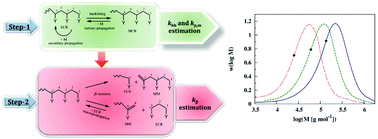From n-butyl acrylate Arrhenius parameters for backbiting and tertiary propagation to β-scission via stepwise pulsed laser polymerization†
Abstract
Arrhenius parameters for backbiting (bb), mid-chain radical propagation (pm) and β-scission in n-butyl acrylate radical polymerization are determined based on pulsed laser polymerization (PLP) inflection point data derived from size exclusion chromatography (SEC) analysis with limited monomer conversion. Laser pulse frequencies ranging from 1 to 60 Hz are only needed as bulk data are complemented with solution data (solvent: butyl propionate) to increase parameter sensitivity and to lower parameter correlations, as confirmable by the calculation of the correlation matrix, without inducing a kinetically significant solvent effect. ‘Low’ temperature (303–323 K) and ‘high temperature (383–413 K) PLP experiments are carried out to further minimize parameter correlations by a step-wise parameter estimation. The former experiments are used for the estimation of the Arrhenius parameters for backbiting and mid-chain radical propagation, with literature Arrhenius parameters for end-chain propagation as input. The latter experiments consider the former Arrhenius parameters as input to reliably estimate the remaining Arrhenius parameters for β-scission. In agreement with literature data, Ea(kbb) is determined as (30.6 ± 5.4) kJ mol−1, ln A(kbb s−1) as 17.8 ± 2.1, Ea(kp,m) as (30.1 ± 9.7) kJ mol−1, and ln(kp,m L mol−1 s−1) as 14.5 ± 3.7. Additionally, Ea(kβ) is estimated as (81.1 ± 18.2) kJ mol−1 and ln A(kβ s−1) as 29.7 ± 5.5, which indicates a higher relevance of β-scission at temperatures around 400 K as previously expected.



 Please wait while we load your content...
Please wait while we load your content...